Some of the links on this site are Affiliate Links and if you use them to make a purchase, we may earn a commission. For more information, read our Disclosure Policy.
Are your food expenses out of control? Do you feel like your average monthly grocery bill could be – or should be – less? If so, it is time to adopt a frugal food budget! To help get you started, I am sharing my top tips for buying groceries on a budget.
Adapting to Buying Groceries on a Budget
Food budgeting can be scary – at least it was for me. The first time I sat down and figured out a reasonable grocery monthly budget I feared we would starve.
Even though I have always been money conscious, our average monthly grocery bill for 2 people was excessive. However, I was determined to change my relationship with money and get our monthly food budget under control so that we could reach our financial goals.
Since I have become more frugal, I am much savvier with our monthly budget for food. I know where in my meal plan I can save, what to stretch and how to get the best bang for my buck.
New to the frugal lifestyle? Use my tips on Creating a Budget and claim your FREE Printable Budget Worksheet here!
Grocery Monthly Budget: How To Figure Your Food Budget
Your average cost of groceries per month depends on several factors – like where you live, where you shop, how many people you are buying for (and what age) and your specific food preferences or requirements.
Because we live a nomadic lifestyle, I constantly adjust our monthly food plan for groceries based on our location. The monthly cost for food in London can be substantially higher than buying groceries for a month in Lisbon. Trying to estimate grocery costs in Southeast Asia can be perplexing (and it is often cheaper to eat delicious street food!).
In America, however, where dining out – and food, in general – tends to be more expensive, it is imperative that we pay close attention to how much to budget for groceries.
Learning how to budget money for food isn’t something I have just done once. Figuring out my grocery budget per month – and how to make it work – is something I do every time we move to a new city…so it’s something that I excel at.
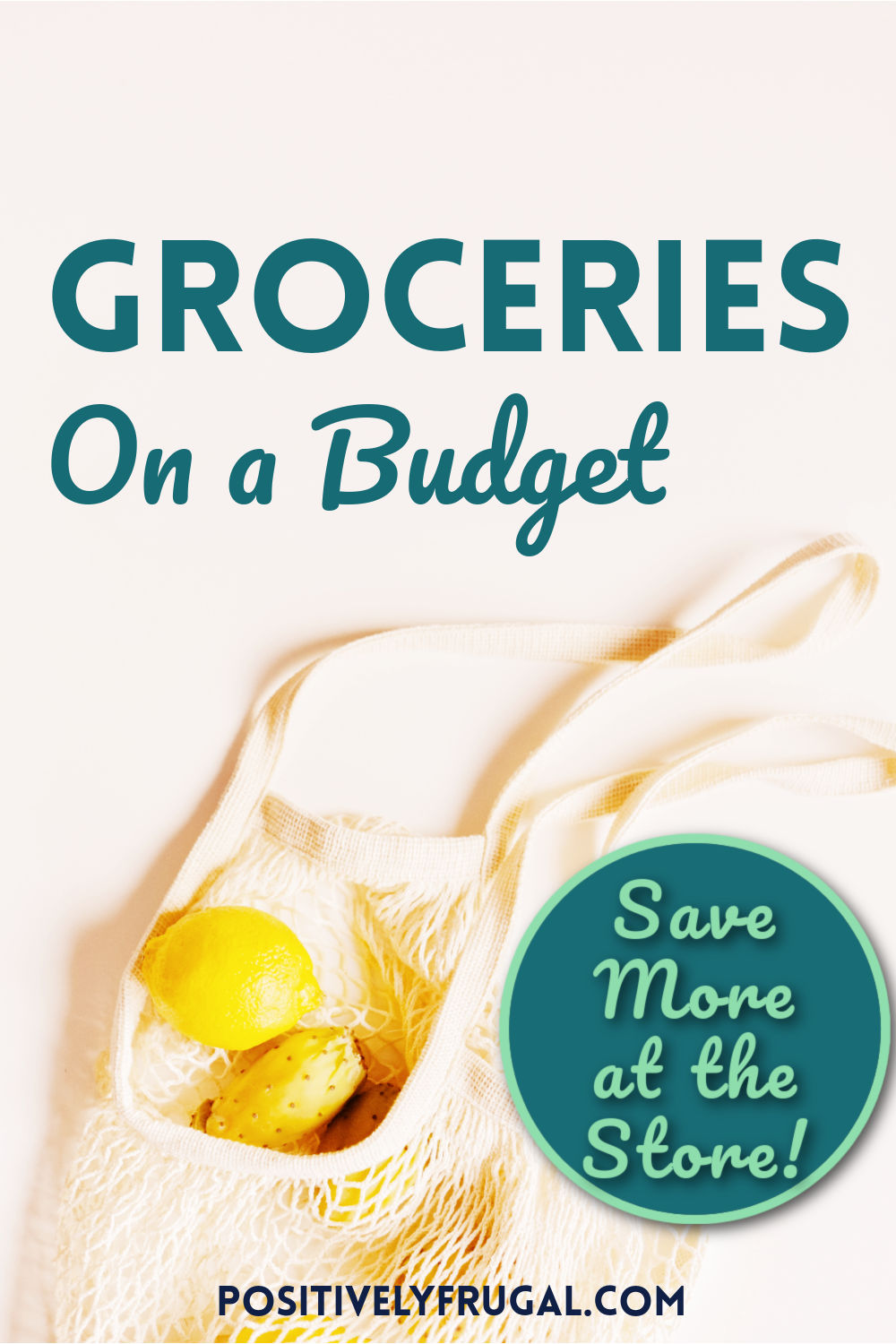
How To Budget for Food Anywhere
While moving around can make our average groceries monthly cost a bit murky and difficult to determine, I am a fanatic about devising a monthly meal plan on a budget. Regardless of whether we are in Paris or Phuket, our average monthly food budget is set at $10 per day, per person – making the average cost of food per month for 1 person $300.
Our per person food budget includes all of the food we consume – plus toiletries and alcohol purchased at the store.
Using $300 for 1 person as a base for my average monthly food cost, I make adjustments to our grocery budget and meal planning as necessary…regardless of where we are in the world.
I’m not indicating that this is how much you should spend on food; your food budget per month needs to jive with your income and overall money goals. When we really need to baton down the hatches, I know how to adjust. In fact, I know exactly what it takes to cut my monthly grocery bill in half. Yep, in half.
How Much To Spend on Monthly Groceries?
I don’t believe there is a one-size-fits-all when it comes to an average monthly budget for food. And – in my opinion – there isn’t a right or wrong when it comes to how much to spend on groceries as long as it is in line with your financial goals.
All that said, if you are reading this frugal blog post because you want to decrease your monthly food cost at the grocery store, I have some stellar tips for how to save on groceries.
If curiosity is getting the better of you and you want an actual dollar figure for food expenses per month, you can check out the average monthly food cost worksheet from USDA to see if your spending falls within the typical grocery budget in the USA.
How Much for Groceries per Month?
I can’t offer a specific figure for how much to spend on food per month. Clearly, a monthly food budget for 1 is going to be vastly different than an average family of 4 grocery bill.
Money guru, Dave Ramsey, suggests you should spend 10-15% of your income on the cost of food per month – and that includes grocery store purchases and dining out.
Personally, I believe that you need to adjust your cost of groceries per month to your own specified budget by balancing your monthly grocery budget with your needs, wants and savings plan.
Challenge Yourself To Spend Less
The grocery budget tips I’m going to share with you are huge money savers and a great place to start with lowering your grocery bill. However, if you need additional motivation to spend less on food, make it a challenge.
For a real challenge, join my $5 Food Challenge and find out how low you can go with your grocery budget!
12 Tips for Buying Groceries on a Budget
I love talking about frugal groceries – and I am bursting with tips on how to reduce your cost of groceries per month. If you want to figure out how to reduce your average monthly cost of groceries and eliminate food waste, then you are in the right place!
Pro Tip: These are grocery store hacks that will assist in your budgeting of food at the grocery store. I talk about more ways to limit monthly food expenses in my blog post, Meal Planning, plus I discuss the pros and cons of getting Groceries Delivered and offer other cost-saving tips in Frugal Cooking!
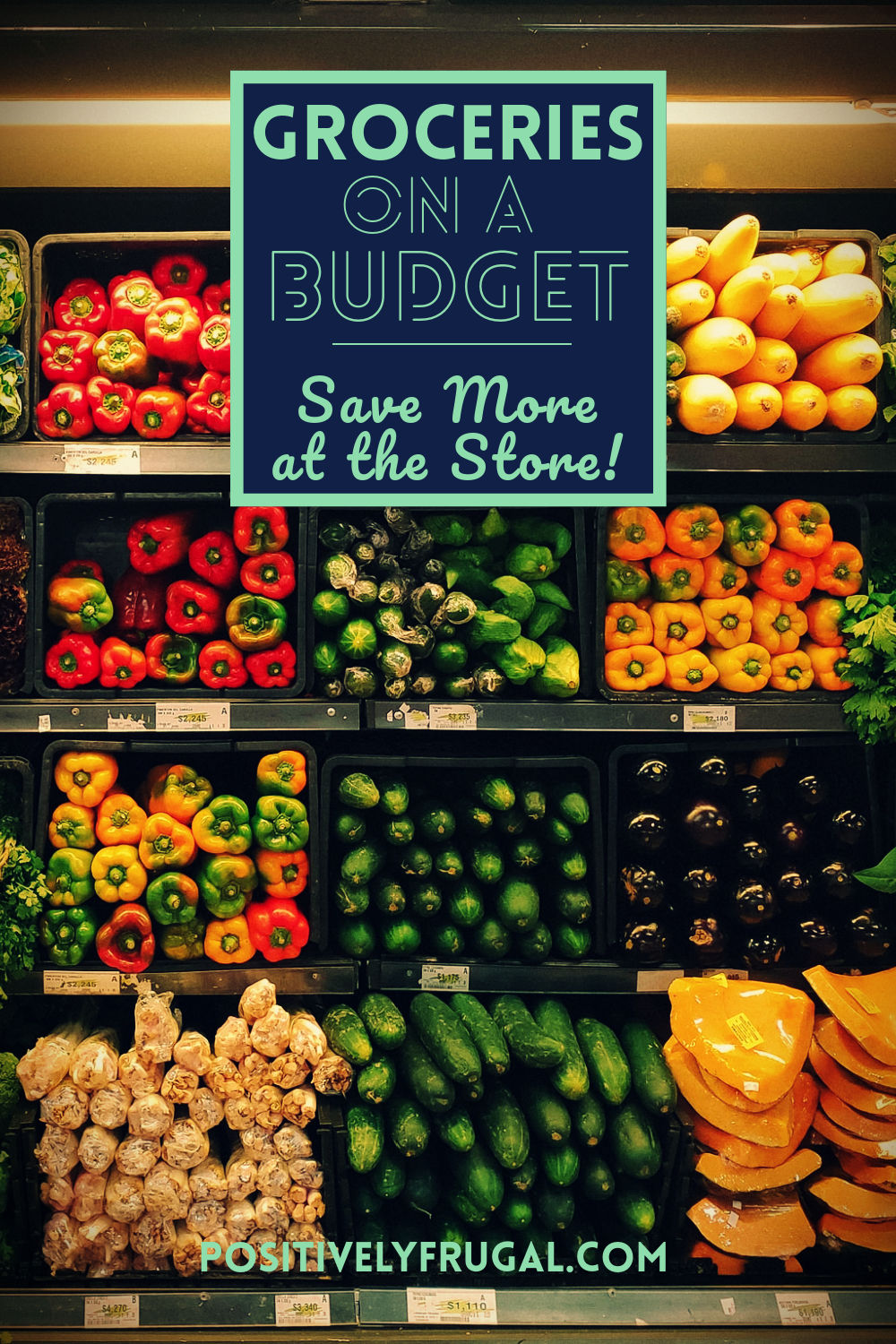
#1 Make a List to Save on Groceries
Rule Number 1 of Grocery on a Budget is shopping with a list.
So, the first step to adhering to Rule #1 is to actually make a monthly grocery list on a budget. I’m talking about a physical piece of paper that you use as a manual of what goes into your shopping cart.
Not only do you need to write down all of the items, but you should indicate on your list the anticipated cost of each item and whether or not you have a coupon (more about coupons in a minute!).
I’ve made lists on used envelopes, Post-it notes and scratch pads. It doesn’t matter where you jot your list, but it should be written down. If you like organization (which is so key to staying on budget!), then you might like the grocery list template in my Meal Planner Printable Kit (that is also included in my bigger Complete Budget Planner Kit).
Using a template makes it easier to keep the list as a reference guide for future grocery shopping trips. You can find my Meal Planner printables and other budget templates on my Shop Page.
If you are curious about the kind of items you will find in my grocery cart, I share specific details in my blog post, The Best Budget Grocery List.
#2 Never Shop Hungry and Keep Your Groceries on a Budget
The second rule to sticking to a reasonable grocery budget is to never ever ever shop hungry. No joking, your average food bill per month will be noticeably lower if you shop on a full stomach. When you shop hungry, you are naturally tempted and you will likely end up buying food that sounds good at the moment, even though you don’t really need it and it’s not on the list.
Personally, I like to go grocery shopping right after a meal – either breakfast or lunch. I also usually have a granola bar with me (either in my bag or the glove box of the car) that I can nosh on before entering the grocery store. This one trick has probably saved me hundreds of dollars.
#3 Buy Foods in Bulk to Save Money on Groceries
A sure-fire way to lower your monthly food costs is to buy in bulk. It’s one of the tried and true ways of saving money on groceries, but only if it is A) a product you will use in its entirety before going bad and B) a product that you actually like!
Furthermore, you need to have sufficient space and an organized system to store the bulk items, ensuring that they don’t get shoved in the back of the fridge or pantry and lost forever.
In order for bulk purchases to benefit your average grocery budget, you need to be organized, watch expiration dates and have a plan to use the items.
#4 Do the Math to Compare Prices
Your cheap food budget plan might not be so cheap if you are not paying attention to the math. When bulk buying or price comparing at the grocery store, it is essential that you do a little math to make sure you are getting the best deal.
Product packaging can be deceptive. The same size box can hold different amounts. Sale prices can trick you.
It is imperative that you calculate cost per unit if you don’t want to spend too much money on food.
Most grocery stores now provide a helpful Price per Unit on the shelf price tag. Use that figure when deciding which yogurt to buy, not the lowest price. If your grocery store does not offer a Price per Unit feature (or if they omit it on sales tags or if you are using coupons), then it is up to you to do the math.
To figure the cost per unit (or per ounce/pound), divide the price by the number of units. You can do the math on the back of your grocery list – but I highly recommend carrying a calculator (your phone likely has one) to the store with you!
#5 Stock Up on Sales and Save on Grocery Bills
Another way to save on the average monthly cost of groceries is to stock up when your favorite products are on sale. This can be especially helpful with a family food budget where you buy the same products week after week.
Don’t just wait for the sales to happen – find out when they will happen and plan your grocery budget around those events.
Stores will often have regular sales throughout the year or month – so track when they occur so that you can take advantage of them.
Peanut butter is a great example. Jars of peanut butter are typically on sale in late summer when school starts, making it a great time to stock up (and even better if you can combine it with a money saving coupon).
Just remember, this trick may increase your grocery expenses per month depending on when the products go on sale (and if they all go on sale at the same time), so be sure to account for that and spend less in future months. To ensure you have the money to spend on big grocery sales, set up a sinking fund and save for it throughout the year.
#6 Buy In-Season for a Frugal Grocery Shopping Experience
Prices of grocery items – especially produce and meat – fluctuate with the seasons. If you are set on making monthly meals on a budget, then your shopping list needs to be in tune with the season.
Summer produce, like berries and avocados, are usually cheapest in the summertime when the crops are plentiful. In the wintertime, when these items have to be shipped in or produced in greenhouses, they are more expensive.
Need some guidance on how to save money at the grocery store when buying produce? Use this seasonal produce guide to help tailor your meals to in-season products. And, of course, always check for what is currently on sale at your local grocer.
#7 Take Advantage of Manager’s Specials when Frugal Food Shopping
I love Manager’s Specials – and snatching up these deals can be a great way to reduce your food spending per month.
As products near their expiration date, they are often drastically reduced and labeled as Manager’s Specials. The meat department, produce department, deli and bakery are all notorious for offering deep discounts on food that is about to expire.
Just last month, I picked up packaged tortillas for 90% off, making them just 23 cents for a package of 10. I also bought a spiral-cut ham that was discounted by 85%, with a final sales price of just $5.50.
However, these deals were only a score because they were items that were already on my monthly food shopping list. Don’t get swayed into buying a Manager’s Special just because it is…special. It needs to fit in your overall average monthly groceries plan.
#8 Use Loyalty Cards, Coupons, Apps and Cashback Cards to Save on Grocery Bill
There is more to buying frugal groceries than the food on the shelf. Another way to buy groceries on a budget is to use money-saving tools.
Loyalty Cards for Cheap Grocery Perks
The best advice on how to budget food shopping is to sign up for the grocery store loyalty card. There is no doubt about it, a grocery store loyalty card can equate to huge savings for your frugal grocery budget.
Never shop without one. Really, it is the easiest way to save money on groceries and absolutely ridiculous to bypass the savings by not having one!
Coupons to Lower Your Grocery Expenses
Coupons are an age-old method of reducing your monthly food bill. In addition to paper coupons that come in the mail and via flyers inside printed newspapers, frugal shoppers can find online offers from manufacturers and grocery stores (often tied in with your grocery store loyalty card) that will help slim down your grocery expenses per month. Check out all my advice on the Pros and Cons of Couponing!
Before You Start Couponing…
Of course, using coupons can help decrease your grocery bill per month…but, I recommend approaching couponing cautiously.
If you’ve been to my homepage, then you may have noticed that I claim to be an ‘occasional coupon clipper.’ That is a true fact. I am an extremely frugal grocery shopper and I only seldom use coupons.
There are two main reasons for this: First, couponing takes time (and time is money!) and, second, most often coupons are for name brand products that I don’t use.
My best advice is to think twice before using coupons. If you are only buying the product because you have a coupon or – worse – buying a product that costs more even with the coupon than the competitor brand, then you are not saving money.
Frgual Grocery Apps to Save Money on Food
Additionally, there are couponing apps, like Ibotta, Checkout 51 and SnipSnap that provide digital coupons that can add up to big savings.
Cashback Credit Cards to Reward Your Supermarket Expenses
On another note, regardless of whether you use coupons or apps, I 100% recommend paying for your grocery shopping with a cashback credit card – like Discover (which provides a $50 bonus just for signing up and using the card!).
Even in an extreme food budget, the cost for groceries per month adds up. Why not use a credit card that gives you a little something extra on your cost of food? Just, of course, be sure to pay off the entire credit card balance each month.
#9 Start Saving on Food and Go All-In with Generic
Once upon a time, generic food brands had a really bad reputation. Although the price was less than name brand products, so was the taste.
Well, things have changed. The status of store brand and generic products has been elevated. In fact, some store brand products are now not only on par with the national brand, but even better.
If you are trying to adopt a more reasonable monthly food budget, consider swapping out name brand products for the cheaper, no-name or store brand.
#10 Know Where To Look…and Where To Not Look
Grocery stores are not in the business of saving you money and most supermarkets have amazing marketing teams that strategically place items they want you to buy.
If you want to save on your cost for food per month at the grocery store, then you might need to change your line of vision.
The eye-level, easy-to-reach products are more expensive than the competitor products lower on the shelf. The sale items are tagged with bright orange stickers to garner your attention, but they are not always the cheapest. The end caps (the items displayed at the end of the aisle) are easy to grab, but better priced products are often available if you wade down the aisle.
#11 Price Shop Your Local Grocery Stores
Shopping on a budget for food is not easy – but with a little bit of research, you can get ahead of the game.
While you may think that all grocery stores are the same, they are not. There are big disparities between products and prices at different supermarkets.
When developing your realistic grocery budget, take some time to do a little price comparison online. Select 5-10 items you commonly buy and then check the prices at three different local grocery stores.
If one store offers overwhelmingly lower prices, then it might be best to do all of your shopping in that one place. However, if you have the time to shop and dedication to stick to your list, then shopping at multiple stores could save you even more money.
#12 Know the Pros and Cons of Online Grocery Shopping
Grocery shopping online is all the rage right now – and it can be a great method for how to budget your groceries (especially if you get free delivery!).
What I love about online grocery shopping is that it calculates your grocery bill as you shop, which can help you ensure that you are staying within your allotted monthly shopping budget. There are no surprises at checkout.
Shopping online also eliminates distractions; you can maintain complete focus without getting swayed to buy things you don’t need (which, we all know, can be a huge struggle once inside the store!).
However, there are a few downsides to the online shopping experience in regards to buying groceries on a budget. For example, most grocers do not accept paper coupons for online purchases.
Furthermore, you do not get to choose your own produce and often product substitutes are not on par with what you would have purchased. Another disadvantage is that you can’t shop Manager’s Specials online, so you might miss out on a stellar deal.
You will have to weigh the pros and cons to determine if online shopping works best for your food expenses.
Bonus Tip: EAT WHAT YOU BUY
Okay, this isn’t necessarily a grocery shopping tip, but it needs to be said (or shouted, in the case of my ALL CAPS proclamation).
If you really want to know how to save money on groceries, you need to eat the food you have already paid for. Any food you throw away is money down the drain.
Don’t let lettuce go bad and don’t ruin your meal plan with spoiled meat. Keep track of your food budget by keeping track of your meals.
Organize Your Groceries Budget
If you are committed to buying groceries on a budget, organization is key. Start with my tips for Eliminating Food Waste to help ensure you consume what you purchase.
However, if this is a known struggle for you, my Meal Planner Kit of Printables might help. Included in the packet of templates are a Weekly Meal Plan, a Grocery List and Recipe Cards for your favorite frugal meals – which are all useful when sticking to buying groceries on a budget!
Use a Monthly Budget for Saving on Groceries
Furthermore, creating an overall monthly budget will help significantly when it comes to figuring out how much to spend on groceries. When you subscribe to my blog, I provide a FREE Monthly Budget Template that you can use to calculate your monthly goals and expenses.
You can find more affordable budget templates and savings trackers on my Shop page.
Interested in more of my Frugal Food Tips? I round them all up (including my favorite Frugal Snacks) on my Frugal Food page!
We Want To Know: How do you manage to buy groceries on a budget? Share your tips and advice in the comments below!
Pin It!
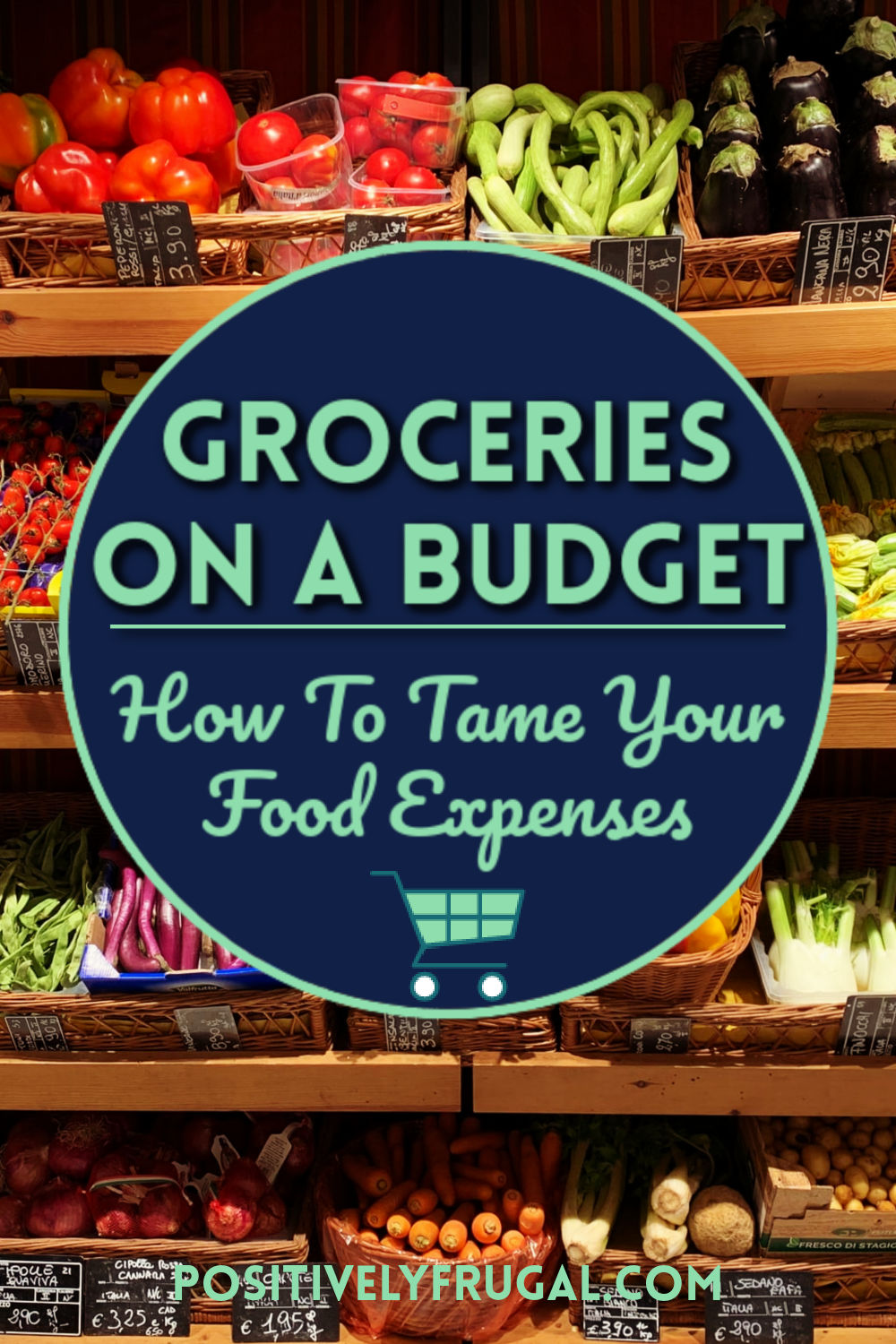
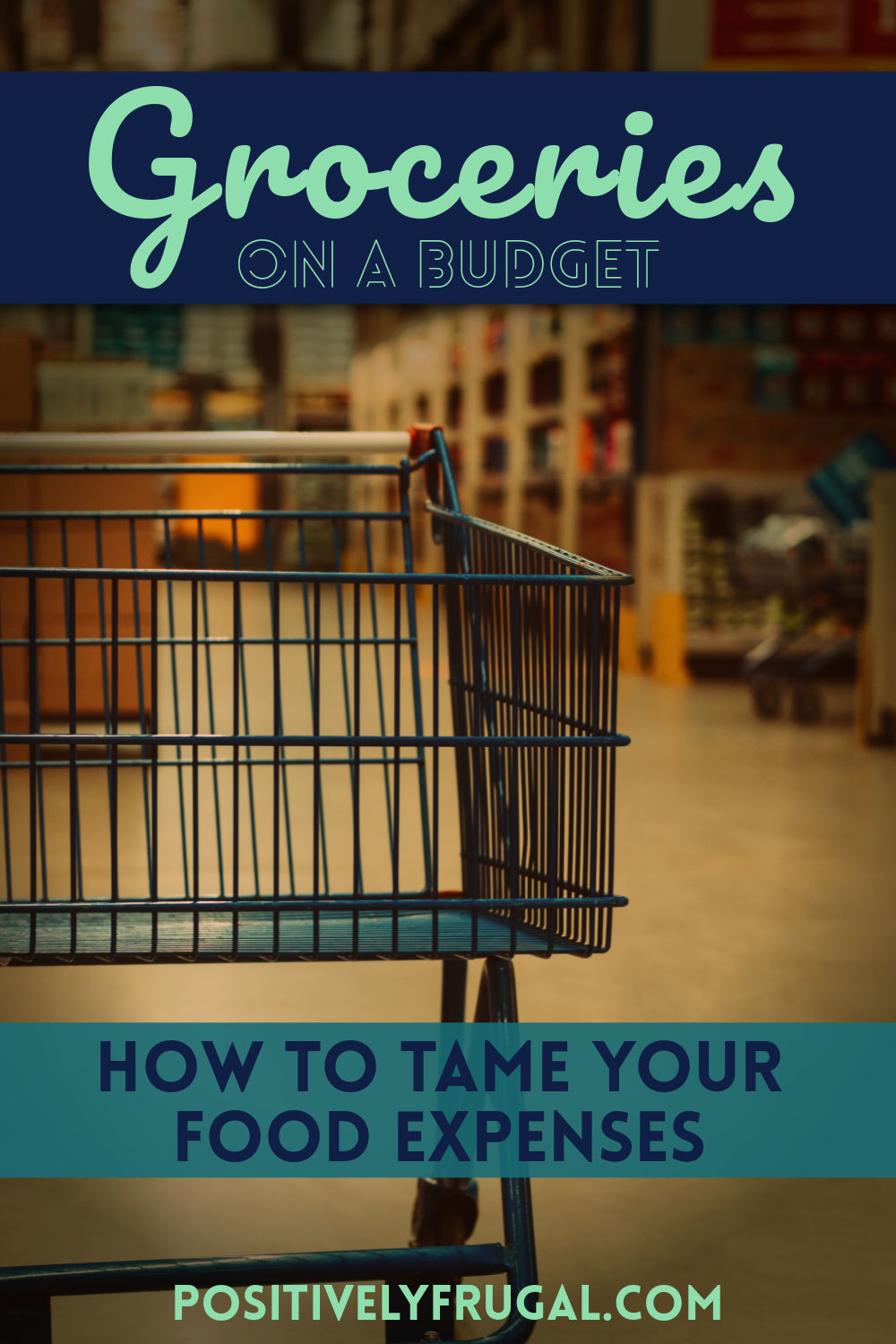

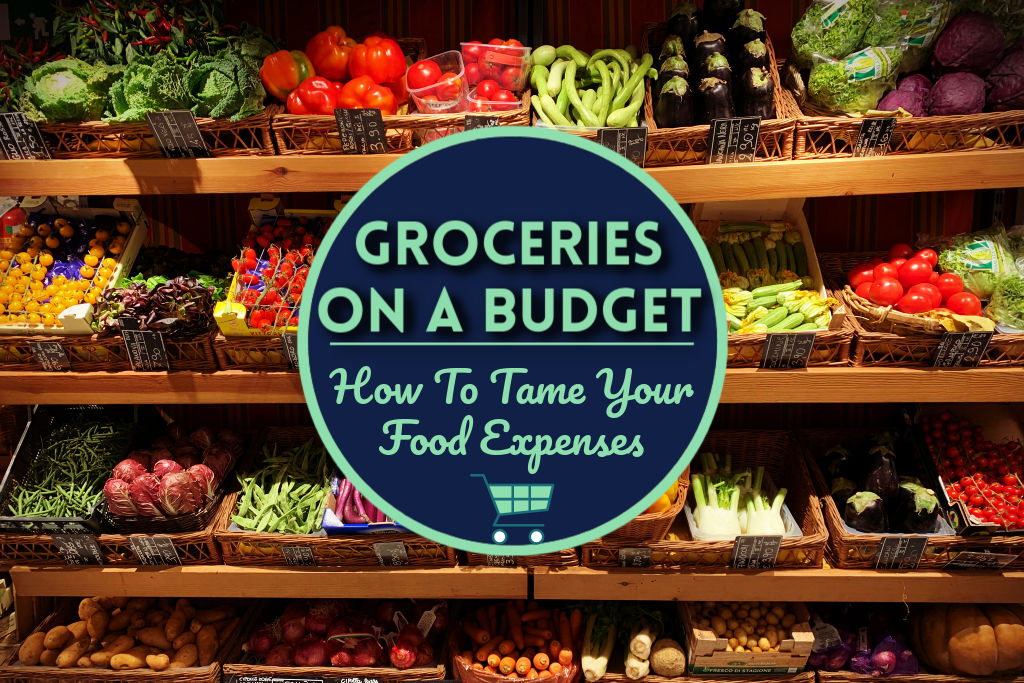


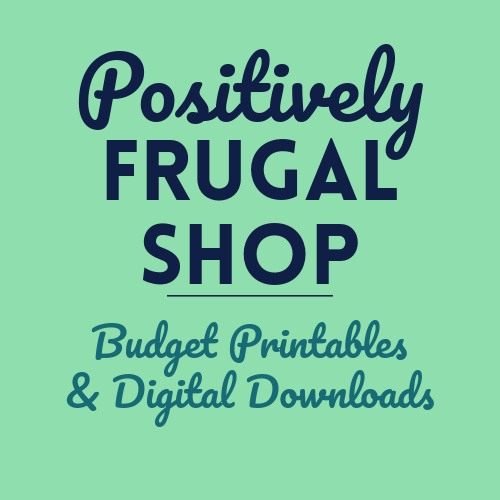
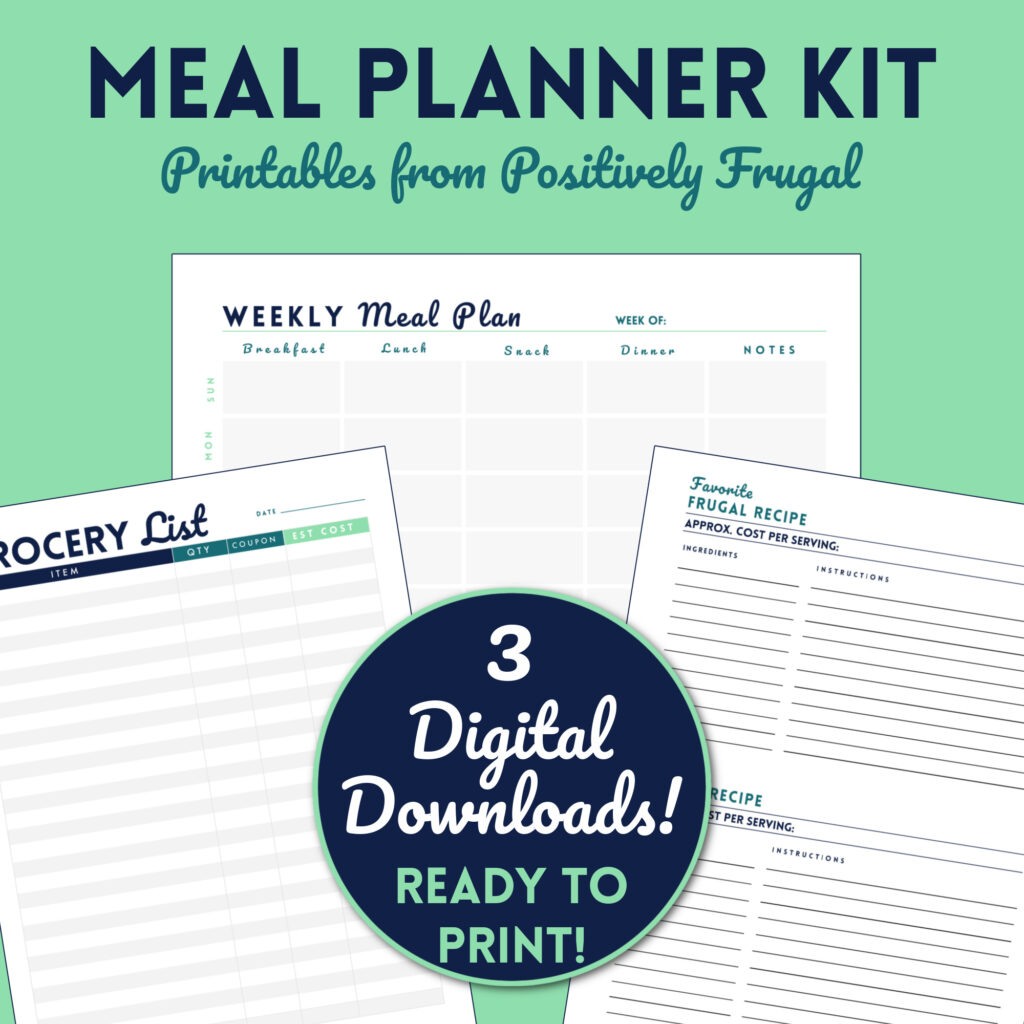

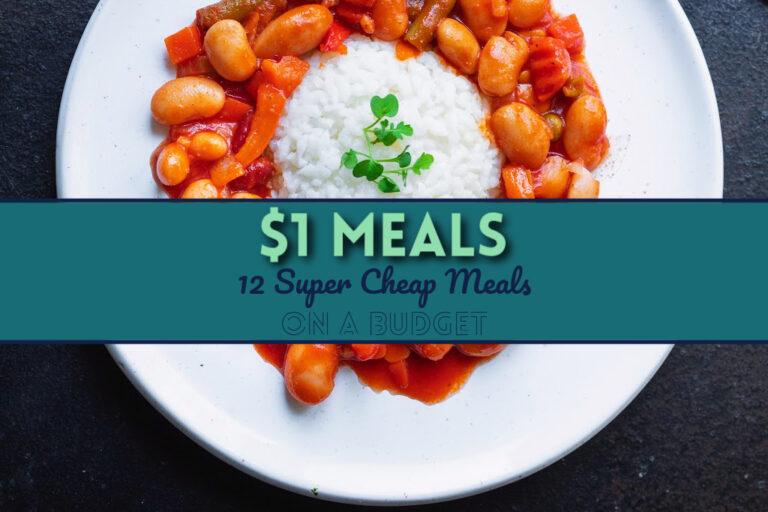
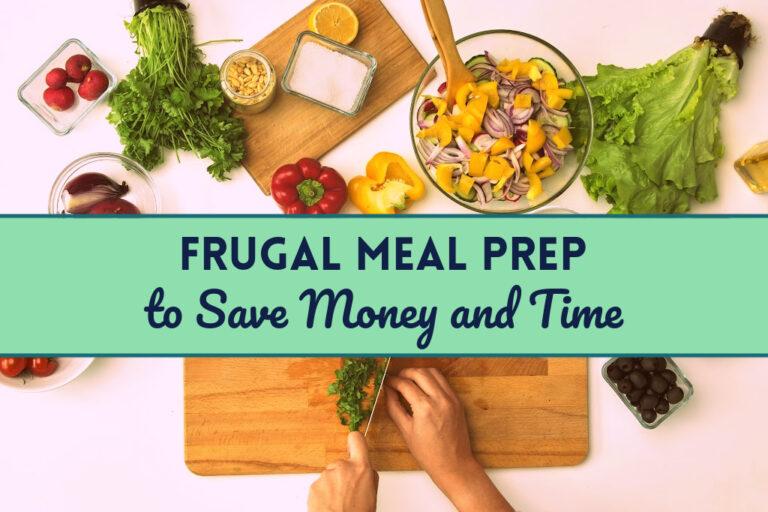
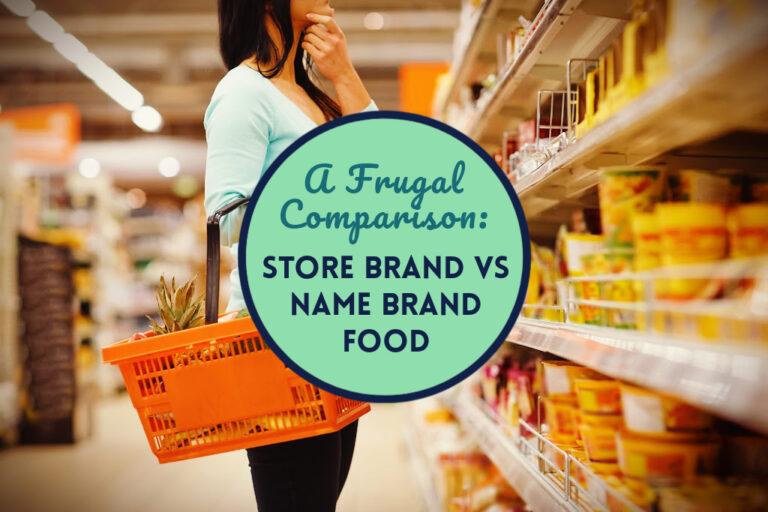
Good Tips! I actually enjoy grocery shopping. I go to Costco for my bulk, Aldis for most because they are the least expensive and I think their produce tastes great and sometimes Meijer for odds and ends. For my family of 4 we spend less than $500 a month for groceries and I have a very well stocked pantry. I use all of your tips to make that happen.
Thank you Tracy and well done on your grocery budget! We’ve been loving Aldi lately:)